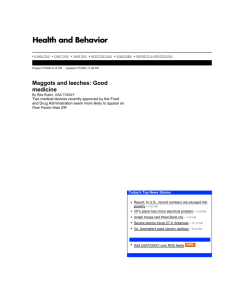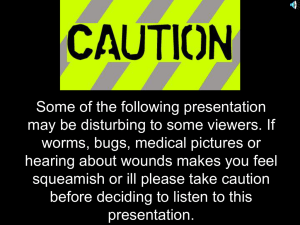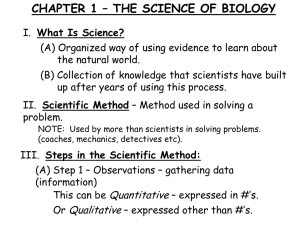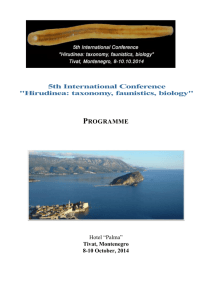Piktochart
advertisement
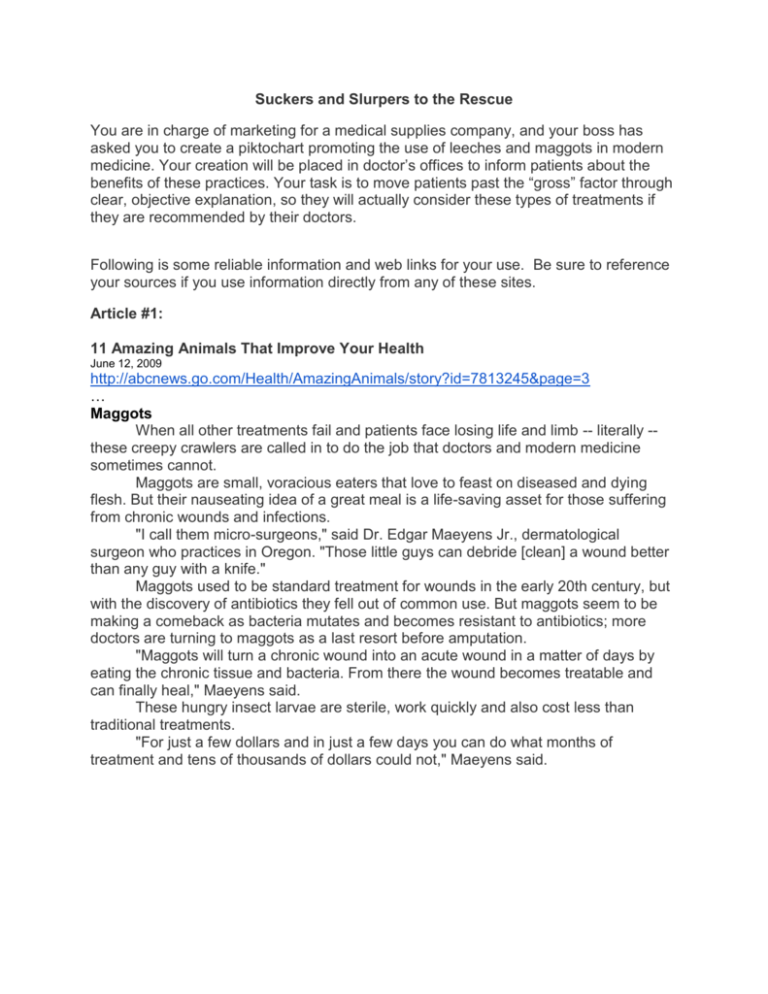
Suckers and Slurpers to the Rescue You are in charge of marketing for a medical supplies company, and your boss has asked you to create a piktochart promoting the use of leeches and maggots in modern medicine. Your creation will be placed in doctor’s offices to inform patients about the benefits of these practices. Your task is to move patients past the “gross” factor through clear, objective explanation, so they will actually consider these types of treatments if they are recommended by their doctors. Following is some reliable information and web links for your use. Be sure to reference your sources if you use information directly from any of these sites. Article #1: 11 Amazing Animals That Improve Your Health June 12, 2009 http://abcnews.go.com/Health/AmazingAnimals/story?id=7813245&page=3 … Maggots When all other treatments fail and patients face losing life and limb -- literally -these creepy crawlers are called in to do the job that doctors and modern medicine sometimes cannot. Maggots are small, voracious eaters that love to feast on diseased and dying flesh. But their nauseating idea of a great meal is a life-saving asset for those suffering from chronic wounds and infections. "I call them micro-surgeons," said Dr. Edgar Maeyens Jr., dermatological surgeon who practices in Oregon. "Those little guys can debride [clean] a wound better than any guy with a knife." Maggots used to be standard treatment for wounds in the early 20th century, but with the discovery of antibiotics they fell out of common use. But maggots seem to be making a comeback as bacteria mutates and becomes resistant to antibiotics; more doctors are turning to maggots as a last resort before amputation. "Maggots will turn a chronic wound into an acute wound in a matter of days by eating the chronic tissue and bacteria. From there the wound becomes treatable and can finally heal," Maeyens said. These hungry insect larvae are sterile, work quickly and also cost less than traditional treatments. "For just a few dollars and in just a few days you can do what months of treatment and tens of thousands of dollars could not," Maeyens said. Article #2 Leech Therapy http://www.pbs.org/wnet/nature/bloodysuckers/leech2.html “Bloody Suckers” 1|2 Leech Therapy They bite, slither, and slide -- and they save fingers and lives. While the sight of a wriggling, blood-sucking leech may make many people feel queasy, the spineless worms can also help people feel better -- as NATURE's BLOODY SUCKERS shows. The ancient physician's art of using leeches has made a modern medical comeback: the worms help doctors do everything from reattach severed fingers to treat potentially fatal circulation disorders. Leeches -- which are found all over the world, living mostly in fresh water -- have long had a place in the doctor's medical kit. Five thousand years ago, Egyptian medics believed that letting a leech sip a sick patient's blood could help cure everything from fevers to flatulence. And in medieval Europe, leeches were so closely associated with doctors that physicians were called "leeches" -- and they used millions of the parasites annually to treat patients. Leeches have been used by physicians since ancient times. In the 20th century, however, most doctors turned away from the worms, which in nature feed on everything from frogs to alligators. A few physicians, however, saw that leeches might play a special role in certain kinds of surgery, by helping promote blood flow to damaged tissue. That's because when leeches bite a victim, their unique saliva causes blood flow to increase and prevents clotting. As a result, once bitten, victims can bleed for hours, allowing oxygenated blood to enter the wound area until veins re-grow and regain circulation. The leech is invaluable in microsurgery when faced with the difficulties of reattaching minute veins. Ears have such tiny veins that, in the past, no one was able to successfully reattach them. Then, in 1985, a Harvard physician was having great difficulty in reattaching the ear of a five-year-old child; the tiny veins kept clotting. He decided to use leeches and the ear was saved. This success established leeches in the modern medical world. Since then, leeches have saved lives and limbs, reducing severe and dangerous venous engorgement post-surgery in fingers, toes, ear, and scalp reattachments; limb transplants; skin flap surgery; and breast reconstruction. Leech Therapy Perhaps the best known advocate of medical leeches is Roy Sawyer, an American researcher. Several decades ago, he recognized the potential benefits of "leech therapy" and started one of the world's first modern leech farms. Today, the company -- Biopharm, based in Britain -- provides tens of thousands of leeches every year to hospitals in dozens of countries. Two species are commonly used in leech therapy, which can last for up to 10 days. Leeches do have their downsides. Sometimes, they slip off patients and reattach themselves in unwanted places. And no matter how helpful, some patients simply can't stomach the thought of a blood-sucking parasite burrowing into their skin. So some scientists have developed a "mechanical leech" that can perform some of the same duties -- without the gross-out factor. Leeches can help promote blood flow to damaged tissue. "In the case of the leech in medicine, we think we can improve on nature," says Nadine Connor, a University of Wisconsin at Madison scientist who in 2001 helped develop the mechanical leech. The device, which looks a little like a small bottle attached to a suction cup, delivers an anti-clotting drug to damaged tissue and then gently sucks out as much blood as needed. And, unlike real leeches, the mechanical version is insatiable and can remove as much blood as doctors think is necessary (real leeches drop off when engorged with blood). "But perhaps the mechanical device's biggest advantage is that it is not a leech," says Connor. "People don't want this disgusting organism hanging on their body. This added psychological stress for both patient and family members compounds an already difficult situation." Other physicians, however, still swear by the natural wrigglers. Leeches, they say, are a nearly perfect -- and selfreproducing -- surgical tool. And the leech's bite, they add, isn't nearly as bad as its reputation. Article #3: Maggots http://www.scientificamerican.com/article/news-science-shows-how-maggots-heal-wounds/ New Science Shows How Maggots Heal Wounds New studies show how maggots clean wounds and help them heal Mar 19, 2013 |By Carrie Arnold PHILIPPE PSAILA Science Source From ancient times until the advent of antibiotics, physicians used maggots to help clean injuries and prevent infection. Because the maggots feed solely on dead flesh, doctors did not have to worry about bugs feasting on healthy tissue. The arrival of antibiotics relegated medical maggots to an artifact of an earlier era. Widespread antibiotic resistance, however, rekindled interest in the use of medical maggots, and in 2004 the fda approved them as a valid “medical device.” Today maggot providers raise the larvae from sterilized fly eggs and place them in tea bag–like packages that physicians apply directly to wounds. (The packages prevent the maggots from crawling off and completing their maturation into adult flies.) As more physicians have turned to the insects to treat wounds, scientists have uncovered the two-pronged process by which maggots work their magic. One study published last year in the Archives of Dermatology showed that maggots placed on surgical incisions helped to clear more dead tissue from the sites than surgical debridement, the current standard of care in which doctors use a scalpel or scissors. “Maggot debridement takes out all the dead and infected tissue, which is necessary for the wound to close,” says lead author Anne Dompmartin-Blanchère, a dermatologist at the University Hospital Center of Caen in France. Surgical debridement is often lengthy and painful, something that maggot therapy eliminates, she adds. A separate study published late last year in Wound Regeneration and Repair by Gwendolyn Cazander of Leiden University Medical Center in the Netherlands and her colleagues found that secretions from the maggots modulate the complement response, a part of the immune system that reacts to invading pathogens and is crucial to clearing infections. Some complement activation is necessary, but too much complement leads to chronic inflammation, which can keep injuries open and vulnerable to infection. Maggot secretions turned down complement activity in blood samples from healthy adults by inhibiting the production of several important complement proteins, and, the researchers found, reducing this overactive immune response speeds up healing. “About 50 to 80 percent of the wounds we see can be healed with maggots,” Cazander concludes. Maggot therapy might sound medieval, but modern medicine seems to show that it works. This article was originally published with the title "Medieval and Modern." Piktochart: https://magic.piktochart.com/


